A teetering wall of gungy green bricks greets visitors to this year’s Venice Architecture Biennale, forming an imposing blockade near the start of the show. The blocks are made of bio-cement, incorporating fishing nets and algae dredged from the depths of the Venetian lagoon. The wall’s steeply sloping gradient follows the curve of global population growth over the last millennium, terminating abruptly near the ceiling to represent the coming peak of humanity.
“What awaits us on the other side of the hill?” asks Carlo Ratti, director of this year’s biennale, as he stands in front of the momentous cliff. The answer is a great heap of gunge. A festering mountain of mould-like gunk is piled up against the back of the wall, apparently an allegory for microbial intelligence. But it could also be a metaphor for much of the work that follows in the sprawling exhibition hall. “The installation reaches towards an alternative ethics,” an opaque caption tells us. “A trans-scalar, trans-species, collaborative plasticity, that is itself just intelligence.”
You might need to bring your scientific dictionary to this year’s exhibition, along with a good deal of patience. Ratti, a professor at the Massachusetts Institute of Technology, where he directs something called the Senseable City Lab, has assembled a mind-boggling cast of 750 participants, about 10 times the usual number, many of them academics, convened under the broad umbrella of “Intelligens”. The 300 or so projects are loosely organised around the themes of natural, artificial and collective intelligence, showcasing experiments in everything from 3D-printing with bacteria, to AI-generated floor plans, to the future of space suits. There are lots of robots and lots of trees, and several combinations of both. Don’t fear the climate crisis, the exhibition seeks to reassure visitors: a harmonious union of technology and nature will save us.

There’s a lot to please gadget lovers. “Humanoids are here!” Ratti announces excitedly, as we come to an apocalyptic enclosure of charred tree trunks, where a robot clumsily stamps its metal feet while another hits a steel drum. Over the six-month duration of the exhibition, he says, these humanoids will learn various skills, including making the perfect Aperol spritz. Nearby, another robot dangles from the ceiling, convulsing inside a steel cage, which was woven by other robots in a Swiss university. Something resembling a sentient photocopier trundles up, opens a flap, and asks me to scan a QR code. It doesn’t load. Further on, more robots are pitted against humans: two Bhutanese craftsmen patiently carve an intricate decorative beam for a new airport, designed by Bjarke Ingels, next to a much cruder version of the same design, carved by an AI-guided robotic arm. “Robotics doesn’t replace craftsmanship but enhances it,” claims the caption, against all evidence to the contrary.
Robotic printers have also been deployed to create numerous globular structures, some that look like termite mounds, others like trees. Dutch architect Winy Maas imagines a “dynamic bio-matter architecture” that cools, filters water, and regenerates, presenting a model inspired by mangrove roots, made of sand, peat and clay. It looks like a set from a sci-fi horror film. Japanese architect Kengo Kuma has used AI to analyse the geometry of fallen trees and generate 3D-printed nodes to join them together. The result is a wayward pile of tree trunks connected with clunky white nodes, far less efficient (or beautiful) than using conventional carpentry techniques. “I hope it’s biodegradable,” says Ratti, fingering the rubbery material, and not seeming to have much of a detailed grasp over the projects on show.
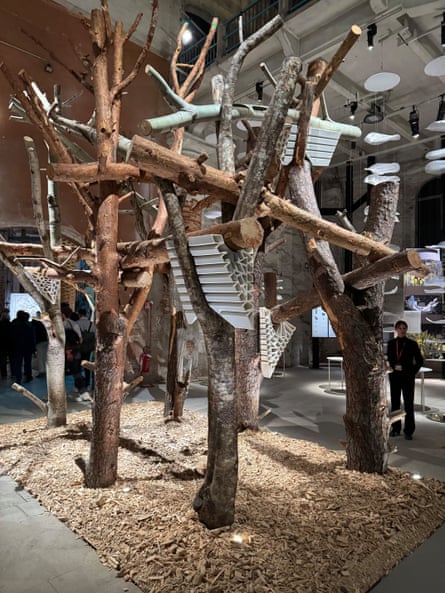
It’s hardly surprising. Rather than judiciously select a group of architects or researchers whose work he values, as is usually the role of a curator, Ratti decided to launch an open call. “I wanted to inject a more bottom-up approach into what is usually a top-down process,” he says. “To create a networked super-organism.” It is an admirable ambition, but one that resulted in more than 1,000 submissions, and little sense of quality control. The upside is that it has given some more marginal, occasionally critical, voices a seat at the table. Activist group the Architecture Lobby has produced a compelling display about the working conditions of architects. “Thank you for your unpaid labour,” declares a big sign on the back of their stand, cleverly positioned next to the stage where the directors of high-profile architecture firms will perform in the coming weeks. There’s a makeshift bridge created by protesters to occupy an endangered forest in Germany, and a film about the renovation of public housing in Europe, but it’s hard to sift the wheat from the chaff in the overwhelming melee.
With the central pavilion of Venice’s Giardini (one of the two main venues) closed for renovation, the exhibits have been jam-packed into the former rope-making factory of the Arsenale. The result is even more chaotic than usual, like a high school science fair on steroids, each exhibitor trumpeting their novel experiment at full volume. Many are the product of university research departments, “and several Nobel prize winners,” adds Ratti, who aimed to imbue the exhibition with the kind of interdisciplinary, collaborative authorship of academic papers. The tone is very similar to the 2021 biennale, curated by fellow MIT professor, Hashim Sarkis, with equally jargon-filled results. The biennale president, rightwing appointment Pietrangelo Buttafuoco, would do well to cast his net wider, perhaps outside the self-involved walls of academe.
The general sense of deja-vu is amplified by the bigger commissions have an oddly retro air. There are the usual self-entitled grandees, teaming up with well-healed sponsors, leading to a quality reminiscent of the Royal Academy Summer Exhibition, where big egos muscle their way in and insist on the spotlight. On one of the most prominent sites, the Norman Foster Foundation has created a big tubular ramp in collaboration with Porsche, wrapped with a billowing skin of metal scales. It looks like an experiment in parametric design from the early 2000s. The team describes it as “a physical manifestation of the intersection of dreams and reality through inspirations of nature and technology”. The ramp leads to a floating pontoon for a fleet of water bikes, one of Foster’s passions, which you can have a go at splashing around on, next to a floating habitat for endangered crickets.
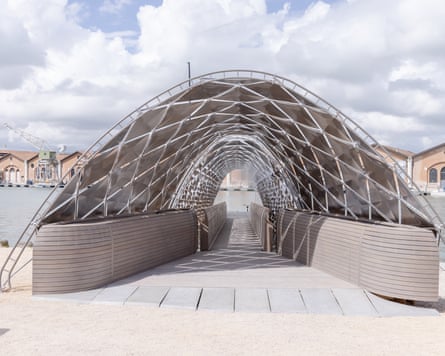
Nearby, 90s design darling Philippe Starck has erected a PVC marquee, housing what looks like a pop-up car showroom for an SUV. “A house for the price of a car,” declares his billboard. Continuing the nostalgic theme, US firm Diller Scofidio + Renfro has revived a proposal they first dreamed up for the 2008 biennale (scuppered by regulatory bureaucracy), to purify Venetian canal water to make espresso. It’s still waiting for public health signoff, but Ratti promises it will soon serve “the best espresso in Venice,” in collaboration with a Michelin-starred chef. Nigel Coates, who also featured in the 2008 edition, is back with one of his whimsical masterplan models made from odds and ends, including bulging phallic towers. But these jokes now feel a bit thin. The world has moved on.
Ultimately, the absence of a tight curatorial vision and judicious editing are the biennale’s biggest flaws, along with the sheer scale of the cacophony. If you spent two full days in the main exhibition alone, you would have just 72 seconds to devote to each participant. Add to that the 66 national pavilions, featuring another 400 contributors, and you’re left with about 45 seconds for each. It’s an impossible feat, like trying to complete the internet. And no more enjoyable.
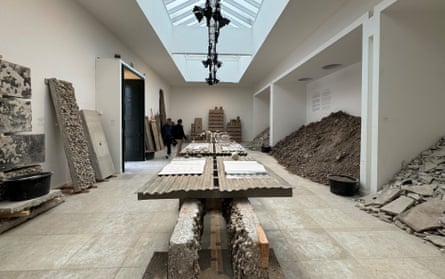
Thankfully, a Dutch architecture magazine, Volume, has come up with a canny aid. Their contribution is a witty critique of the biennale format, in the form of an AI-driven app that helps visitors make sense of the ordeal. You can input your interests, choose the personality type of your guide, and it will create a tailor-made itinerary, as well as decode the impenetrable jargon on the wall, “like a Tower of Babel in reverse”. Based on the written content produced for last year’s (smaller) biennale, Volume editor Stephan Petermann says it would take the average reader more than two years to get thought it. Start now, and you might just have a chance to digest this year’s offerings before the next biennale in 2027. Or, as the curators did to generate their caption summaries, you could feed it all into ChatGPT.
While the main exhibition might leave you with indigestion, the giardini – the garden that is home to most of the national pavilions – provides a refreshing foil this year, partly because so many of the pavilions are closed. The Czech and Slovak base is shut for renovation, as is the French (they’ve put their exhibition on scaffolding around the building instead). Warmongering has shuttered the Israeli and Russian pavilions although Thomas Heatherwick is hosting an event in the latter, posing the question: “How do we make the outsides of buildings radically more human?” Not bombing them might be a start.
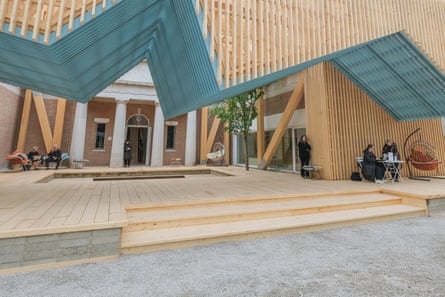
Fittingly, given the current level of global destruction, repair and renovation is a recurring theme. The Danish pavilion looks like a bomb has gone off inside, its rooms filled with mounds of rubble, showing the real-time renovation works that architect and curator Søren Pihlmann is carrying out to the 1950s building. Brawny chunks of material salvaged during the refit have been turned into a rugged range of benches and plinths. The Finnish pavilion takes a similar tack, showing films of the meticulous maintenance work carried out to the Alvar Aalto-designed pavilion, highlighting the people involved, as well as the contribution of Aalto’s wives, Aino and Elissa, to his celebrated work, challenging the history of authorship.
The US pavilion is a folksy hymn to the country’s love affair with the porch. They have built an angular wooden stoop, by Marlon Blackwell, in front of the neoclassical pavilion, screening the building’s pedimented portico – one in the eye for the Trump administration’s classical beauty mandate. Meanwhile, Japan has fun with AI, assigning the different parts of its pavilion individual personalities, and leaving the language model to generate evermore surreal dialogues, as columns argue with the walls. It reads as a gently mocking critique of the earnest, technocratic uses of AI on show elsewhere. Poland is similarly playful, taking a poetic approach to the sense of security that architecture is supposed to provide, and riffing off Polish traditions of adding features to buildings to protect against ill fortune. Their dazzling niche for a fire extinguisher, tiled with decorative stones and shells, elevates the prosaic piece of safety equipment to something with the status of a household god.
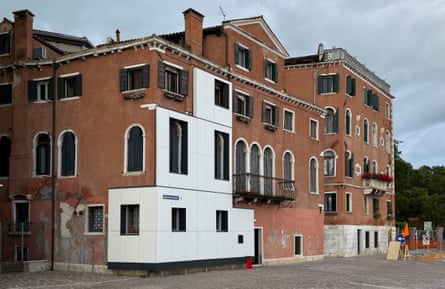
Outside the giardini, the Hong Kong contribution is another highlight, celebrating the region’s history of bamboo scaffolding (now under threat after a recent mandate) and spotlighting a number of important postwar buildings, increasingly at risk from demolition. Ukraine’s pavilion takes a poignant look at the country’s vernacular housing, and DIY efforts to rebuild and maintain it against endless Russian aggression. But Estonia’s pavilion packs the most powerful punch of all. Its curatorial trio of young female architects somehow wangled permission to clad the corner of a prominent waterfront palazetto with ferociously ugly white panels, as a searing critique of the country’s programme of wrapping mass housing with clunky exterior insulation. It’s a brilliant one-liner, supplemented by entertaining stories of residents’ struggles inside.
And what about us? Once again, the British pavilion suffers from the usual affliction of wanting to be a group art show, combining several disparate commissions under a tenuous theme, this time the Great Rift Valley. Models made from 3D scans of caves in Kenya stand alongside a project about the reconstruction of Gaza, graphite murals inspired by space debris, and a proposal for a Kew Gardens palm house as a “site for generative justice”, clad with tiles of bioplastic and fungi. It’s a confusing muddle, but at least it looks good from outside. The classical building is shrouded with a diaphanous curtain of beads baked from Kenyan earth, as a comment on colonial extraction.
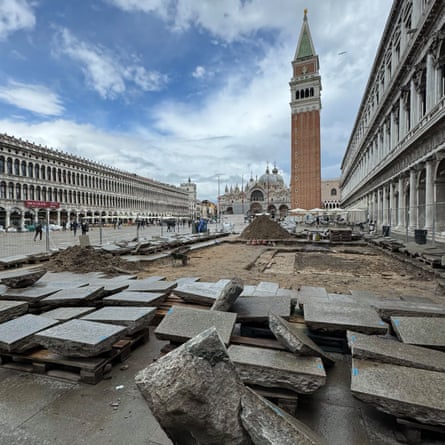
Across town, two collateral exhibitions are well worth seeking out. Infographics nerds will rejoice at OMA’s magnificent haul of diagrams on show at the Fondazione Prada, ranging from early Islamic charts of the body to maps of modern warfare. The new San Marco Art Centre, SMAC, is also a treat, with an exhibition on the under-appreciated Australian modernist Harry Seidler and the Korean female landscape architect Jung Youngsun. It’s nice to be reminded of what curatorial clarity looks like.
But the most compelling architectural exhibit of all is available outside, for free. Piazza San Marco, symbolic heart of the Venetian empire since the ninth century, is now being dug up, as part of ongoing improvements to the drainage system. Marvel as gigantic slabs of Paduan trachyte are heaved to and fro, their undersides ruggedly hewn from the Euganean hills in the 1700s, and carefully put back on new bedding above the swamp. Now that’s some real intellgens in action.

 6 hours ago
8
6 hours ago
8













































